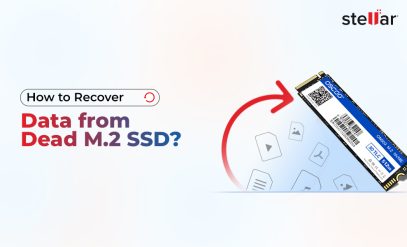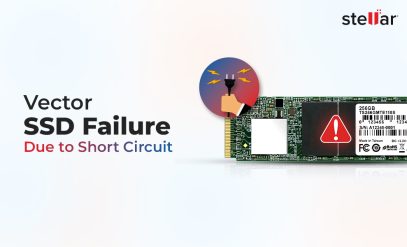Fix SSD Bad Blocks and Reallocated Sectors: Causes, Symptoms, and Data Recovery Options
If you’ve noticed your SSD slowing down and throwing SMART warnings, or if it’s taking a long time to read certain files, don’t ignore it. All of these are early signs that some of your SSD’s blocks (memory cells) are starting to fail.
At first, your SSD will quietly mark these areas as “bad blocks” and shift your data elsewhere using something known as reallocated sectors. But as the number of these bad blocks grows, you’ll start seeing symptoms of SSD failure like corrupted files, SSD lag, or even missing data.
So buckle in as we explain what causes bad blocks and reallocated sectors in SSDs, how to check for them safely, and how Stellar SSD data recovery experts can help you recover data from an SSD with a large number of bad blocks and reallocated sectors.
Root Causes of Bad Blocks and Reallocated Sectors in SSDs
Unlike a hard drive, where bad sectors are caused by damage to the platter surface, bad sectors on SSDs are formed by NAND cell wear-out from too many program/erase cycles (or from voltage instability).
If that’s too much jargon, let’s simplify it. Unlike hard drives that use magnetic platters, your SSDs store information in NAND flash memory cells in the form of electrical charge. Data can be written to or deleted from these cells only a finite number of times (typically, 1000–3000).
Over time, as these cells wear out, they lose their ability to hold an electrical charge, and once that happens, the block becomes “bad.” So each time data is written to or erased from an SSD cell, it slightly wears down the cell, which eventually leads to bad blocks.
🧠 Note: At a deeper technical level, your SSD’s controller uses a system called the Flash Translation Layer (FTL), which maps logical addresses to physical NAND cells. When this controller detects ECC (Error Correction Code) failures that exceed correction limits, the FTL can reallocate that address to a reserved spare block. Though this preserves your data’s integrity, it also reduces the total available lifespan of the drive.
A few isolated bad blocks are normal, especially as your SSD ages. But if you notice your reallocated sector count rising consistently or SMART showing warnings like “Reallocation Event Count” or “Uncorrectable Error Count,” it’s a clear sign that your SSD is wearing out faster than expected.
Common Symptoms of Bad Blocks or Reallocated Sectors
Bad blocks don’t just appear suddenly out of thin air—they build up over time, and only when the SSD reallocated sector count gets too high do they give you problems. But there are some signs that your SSD will give you even before complete failure, and if you can catch these early symptoms, you can back up your data in time and send the drive for repair. These are the common symptoms of bad blocks on SSDs.
⚠️ SMART warnings or health alerts: Your drive monitoring tools (like CrystalDiskInfo or the manufacturer’s utility) show rising “Reallocated Block Count” or “Pending Sector Count” values. These are your SSD’s early distress signals, but you have to do this SSD health check yourself to know.
📁 Files become unreadable or corrupt: Some of your files may refuse to open or can show unexpected read errors. This is especially true for larger ones stored in heavily used areas of the drive.
🕒 Slow read/write operations: Copying or moving your data suddenly takes longer than usual, and the system responsiveness drops sharply when your SSD is under load.
🔄 Frequent retries or pauses: The controller keeps attempting to read failing cells before it eventually reassigns them, and this causes visible lag or system hangs.
💻 Drive disappears intermittently: During intensive I/O tasks, your SSD might disconnect momentarily and reappear after you restart. This is often due to firmware recovery loops.
⚠️ Caution: If any of these signs persist, it’s very important that you stop unnecessary writes and back up your data immediately. Each new reallocation event means your SSD is nearing hardware-level failure.
Read the next section to know what fixes you can try.
SSD Bad Blocks and Reallocated Sectors—Safe Fixes and Diagnostic Steps
In cases of SSD showing bad blocks or reallocated sectors, you need to act early. And no, this doesn’t mean that you rush to “repair” the drive. Instead, your focus should be on diagnosing the problem safely and preserving your data. Here’s how you can do that.
1. Back Up Immediately if Errors Appear
If your SMART data shows growing reallocated counts or bad block warnings, take it seriously. Copy all your essential data to another drive or cloud storage before you continue any diagnostics. The more you use your failing SSD, the faster the damage will spread.
2. Check the SMART Health Status
Start with CrystalDiskInfo or your SSD manufacturer’s utility. Specifically, look for these parameters: Reallocated Block Count, Uncorrectable Error Count, and Reallocation Event Count.
CrystalDiskInfo interface
If these numbers remain stable, keep monitoring them every month. But if they increase steadily, you can be sure that your SSD’s NAND cells are wearing out.
3. Run the Manufacturer’s Diagnostic Tool
Each SSD brand (Samsung, Crucial, Kingston, Sandisk, etc.) has its own tool to test for bad blocks and firmware issues. These tools often display the number of reallocated sectors and can perform surface scans without writing over your existing data.
4. Update the Firmware
After your data is safely backed up, you can try and update the firmware. Outdated firmware causes mismanaged wear leveling and block remapping. Visit your SSD manufacturer’s official website to check for updates (type in “[SSD brand name] firmware update” on Google). Just make sure you don’t interrupt this update process because a failed firmware flash can make your SSD unreadable.
5. Avoid Zero-Fill or Format Tools
If the firmware update doesn’t fix the issue, you might be tempted to try out full formats or zero-fill utilities online that claim to restore SSD function. Our advice—don’t!
These tools can accelerate failure because they rewrite data across every block, including weak ones. If your SSD already has bad blocks, these utilities can trigger more reallocation events and permanently erase data that would otherwise have been recoverable.
We understand that this information can be a bit overwhelming for beginners, so we’ve put together this quick reference table that helps you interpret what your SSD’s SMART readings mean and what you should do next.
| 📊 SMART Reading | What It Means | Recommended Action |
|---|---|---|
| Reallocated Block Count = 0 | Drive is healthy | Monitor once a month |
| Slowly increasing count | NAND wear beginning | Back up data; reduce heavy writes |
| Rapid increase or uncorrectable errors | Controller running out of spare blocks | Stop using SSD; seek professional recovery |
When you see the reallocation rate begin to spike, your SSD is effectively on borrowed time. Now onwards, every new bad block is going to reduce the available space for wear leveling and increase the risk of total failure occurring. At this point, the safest recourse is to contact a professional data recovery service like Stellar.
When SSD Bad Blocks Indicate Imminent Failure (and How Stellar Can Help)
Get this—once your SSD’s pool of spare blocks is exhausted, even a small write or firmware operation is going to cause data loss across multiple memory pages. This is when it’s time to hand things over to professionals—Stellar’s SSD Data Recovery specialists.
How Stellar Can Help
Professionals at Stellar’s SSD recovery labs across India are equipped to handle exactly this type of SSD failure—when your drive is on the edge of collapse due to severe NAND wear or controller instability. This is the process we follow.
| Recovery Step | What Stellar Does | Purpose |
|---|---|---|
| 1. Firmware-Level Diagnosis | Our engineers analyze the SSD’s controller behavior, ECC logs, and SMART history to determine whether failure is firmware, power, or NAND related. | To isolate the root cause safely without triggering further degradation |
| 2. Safe Data Imaging | Your drive is then cloned using hardware-level imagers that bypass bad or slow sectors and handle repeated timeouts gracefully. | To capture every readable bit before the controller fails completely |
| 3. Direct NAND Data Extraction | If the controller is beyond repair, data is read directly from NAND flash chips using chip-off or pinout techniques. | To recover data even when the drive no longer communicates via SATA or NVMe |
| 4. Data Reconstruction | Extracted raw data is pieced back together using Stellar’s proprietary mapping tools. | To rebuild files into their original structure with verified integrity |
Stellar Data Recovery is India’s leading professional data recovery service provider, offering expert solutions for SSDs, hard drives, RAID servers, and more. Their specialists can help you recover data from any storage device with complete safety and confidentiality.
✅ All of this takes place inside ISO-certified labs, ensuring no risk of electrostatic or other damage during recovery.
✅ In many cases, Stellar’s engineers can even rebuild damaged ECC tables and reconstruct controller metadata manually (something ordinary recovery software and local vendors simply can’t do).
So, if your SSD is showing rising reallocated counts, frequent freezes, or disappearing files, it’s best to stop immediately and let Stellar’s SSD recovery experts handle it. Acting early can be the difference between a partial recovery and total data loss!
Preventive Measures to Reduce Bad Block Formation
SSD bad blocks are inevitable as time passes, but you can slow down their formation and extend your SSD’s lifespan with these few simple habits.
⚡ Use a stable power source: Power surges or sudden shutdowns can interrupt write cycles and corrupt NAND pages. Always use a UPS or surge protector for desktops.
🔄 Enable TRIM: This allows your SSD to clear invalid data and manage its free space efficiently, preventing early block wear.
🌡️ Maintain safe temperatures: Excessive heat accelerates NAND degradation and controller stress. Keep your SSD temperatures below 70°C with proper airflow.
💾 Keep firmware updated: Firmware patches fix wear-leveling bugs and improve error correction efficiency.
🧹 Avoid filling your SSD completely: Maintain at least 10–15% free space so the controller can perform garbage collection and wear leveling effectively.
🧭 Monitor drive health regularly: Check your SSD’s SMART data every month using CrystalDiskInfo or your manufacturer’s monitoring tool.
☁️ Back up important data frequently: Even a well-maintained SSD can fail unexpectedly. Use both local and cloud backups for your critical files.
🔍 Other Common SSD Errors You Should Know
Our SSD recovery experts have found that issues like bad blocks and reallocated sectors are just the beginning. SSDs may also face various performance glitches and reliability concerns that can impact your data and drive health. Discover detailed guidance and expert-recommended fixes in the topics below.







